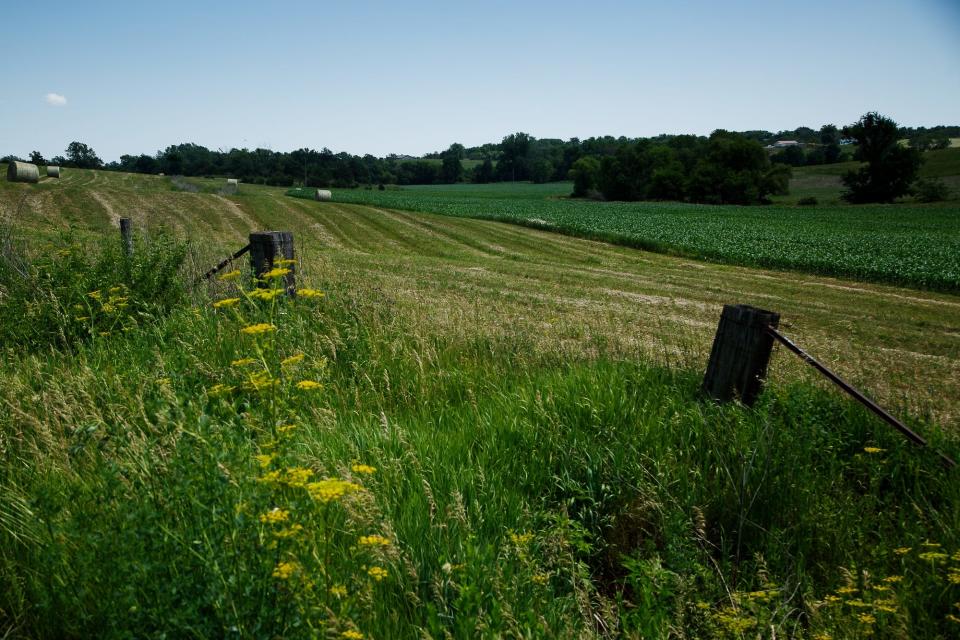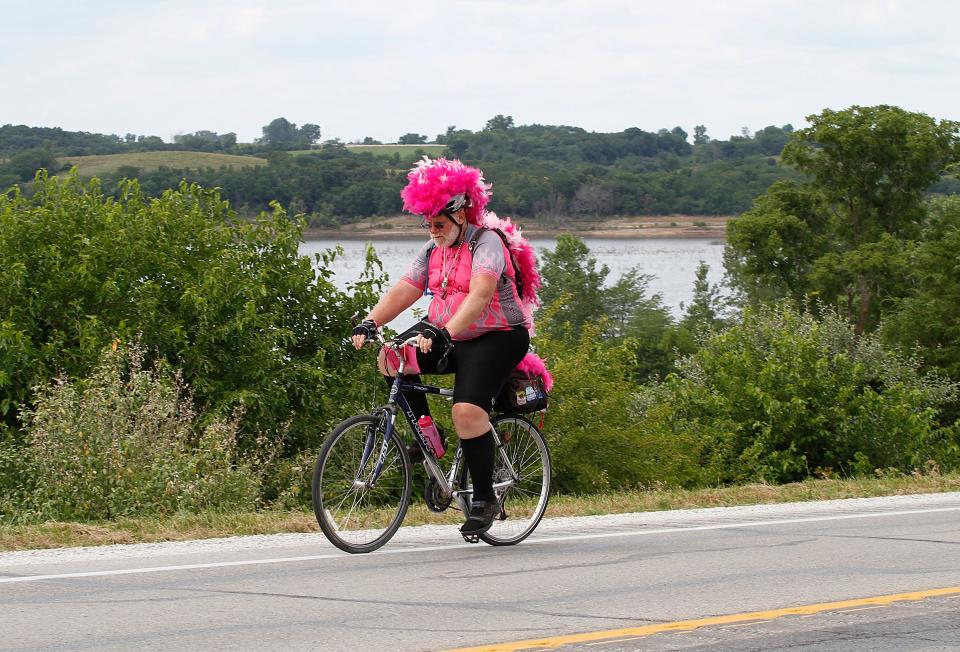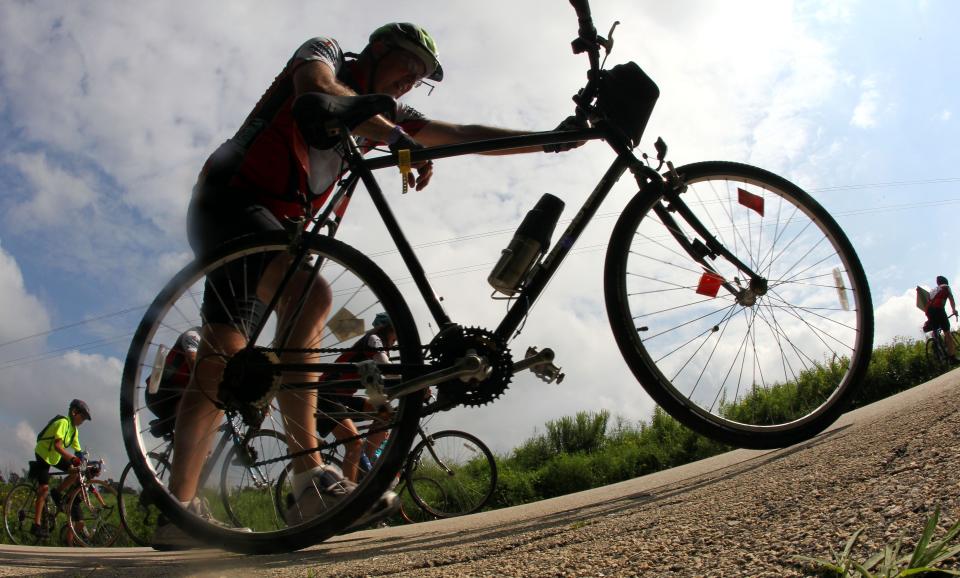How you can conquer the hilliest RAGBRAI ever: an expert's advice
Most. Elevation. Change. Ever.
Even for experienced riders on RAGBRAI, the prospect of riding the super-hilly 51st edition can be intimidating.
From July 21 to 27, riders will trek 424 miles from Glenwood to Burlington, traversing the relentless topography of southern Iowa for the first time in five years. Along the way they will overnight in Red Oak, Atlantic, Winterset, Knoxville, Ottumwa and Mount Pleasant.
What to know about the towns on RAGBRAI's 2024 journey through southern Iowa

The routes between those towns will be released in April, but there are sure to be plenty of hills. Every day has at least 1,100 feet of climb. The third day will be the hilliest, at 4,384 feet.
With 22 weeks to go, it's time to prepare.
David Ertl, a USA Cycling certified coach who has written a training blog for RAGBRAI.com since 2009, said riders should strive to cover at least 1,000 miles in training rides before RAGBRAI.
"Too bad the route profile isn't out yet, but it's going to look like a sawblade, I'm pretty sure, with little ups and downs all the way across," said Ertl, coach of the Des Moines Cycle Club Race Team.
Believe you can do it
Riding hills is as much mental as it is physical, Ertl said. If you think they can make it up a hill, it will be a lot easier than if a hill intimidates you, he said.
"In that case, the hill has already won," he said.
Believing you can make it up is half of the battle, he said.
"One of the reasons for training on hills is just to develop the confidence that you can do it," he said. "You don't have to do it fast, but you can do it."
Respect hills, but don't obsess about them, he said.
"You don't do it because it's easy," he said. "You do it for the fun and the challenge of it and the satisfaction of doing it."
With months until the big ride, seek out hills to train on, Ertl said.
"Most people try to avoid them," Ertl said. "So what you need to do is purposely go out and find hills. You've got to go out and ride hills. Find them and do them over and over again if you have to, if there's only one hill around."
'Use your gears'

Most modern bikes have three gears on the big sprocket in the front and at least six gears on the back cassette. Some bikes have many more gears. New riders should learn how to work their gears "and then use them," Ertl said.
When going uphill, try to maintain a cadence — the speed at which you pedal — close to your cadence on a level roadway, he said. Maintain a pace that will allow you to breathe well, prevent your legs from cramping and stop your heart rate from going through the roof, he said.
"Hills, if you slow down and use low gear, it's not that much worse than riding on the level," he said. "You've got to pace yourself and don't burn yourself out."
Turn hills into cardio workouts

A tried-and-true technique of professional cyclists is to turn hills into cardio workouts instead of pure tests of strength, Ertl said. On tough hills shift down to low gears earlier than you think you should, before the resistance gets too hard. Instead of pushing up hills with your muscles, spin up hills with a faster cadence than if you pushed through it. It should feel similar to being on a stationary bike during a spin class.
This takes the burden off of the muscular and skeletal systems and allows the cardiovascular system to propel you uphill. During long rides this can save energy and allow legs to replenish short-term anaerobic energy, which can be used to push up other hills later.
"Use your gears and try to keep your cadence somewhat like it is on the level," Ertl said. "That keeps it more aerobic and less muscular."
What if there are no rideable hills around me?

Some RAGBRAI riders travel from states like Florida with few hills, Ertl said. Others find it difficult to find hills without riding on busy highways. That's the case in central Iowa, where there are hundreds of miles of paved rail trails on routes converted from old railroad lines as flat as pancakes.
If there are no hills around you, just shift to the highest gear and "grind away," Ertl said.
Do another uncomfortable thing and find headwinds to ride into, Ertl said. Again, this may be an intimidating concept for new riders, but the wind pushing against you is similar to the drag of gravity as you try to travel uphill.
"I tell people you may not have hills, but I bet you have wind," Ertl said.
Increase your workload during the season
It will also be important to log many miles as you train, Ertl said. On average riders should ride 50 miles per week between now and RAGBRAI, he said.
"That's nothing," Ertl said. "Aim for that. That should be a minimum. You can do more."
Each year RAGBRAI puts together a training plan for riders to follow, available at ragbrai.com/wp-content/uploads/2024/02/RAGBRAI_Training_Plan_2024.pdf. The plan steadily increases the number of miles ridden each week. At its peak the training plan suggests riders ride 135 miles during the week of on July 1 and then ramp down before RAGBRAI.
When the overnight towns were announced in January, RAGBRAI Ride Director Matt Phippen stressed that riders need to be prepared to ride when they arrive in Glenwood. Ertl seconded that.
Most hills in Iowa are "not that long," Ertl said. On RAGBRAI, people struggle the most with them on hot, windy and hilly days, like the sixth day of the tour last year.
"That's when it gets hard," Ertl said.
By riding plenty of miles and hills before RAGBRAI, riders should be prepared for anything, he said.
The bottom line is exactly what you'd expect.
"The fitter you are, the better able you'll be able to handle hills," Ertl said.
And if you just can't muster the energy and you have to walk your bike up an especially steep hill, you can assuage your wounded pride with the knowledge that you won't be alone.
Philip Joens has ridden RAGBRAI 18 times and completed the river-to-river trek seven times. He covers retail, real estate and RAGBRAI for the Des Moines Register. He can be reached at 515-284-8184, at [email protected] or on Twitter @Philip_Joens
This article originally appeared on Des Moines Register: How to survive the hilliest RAGBRAI ever